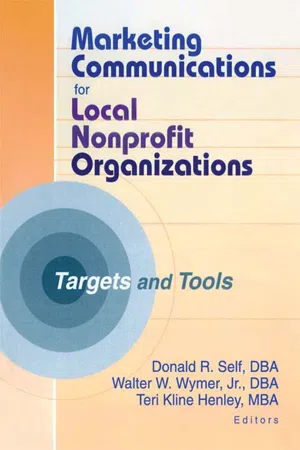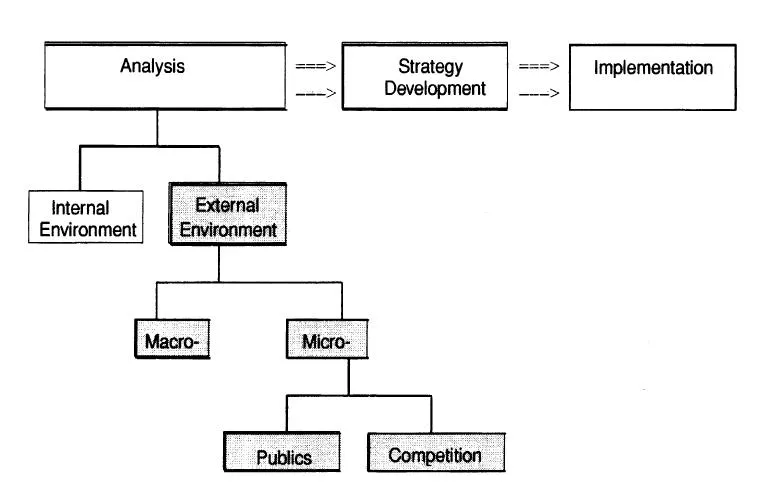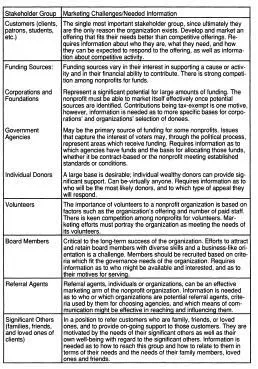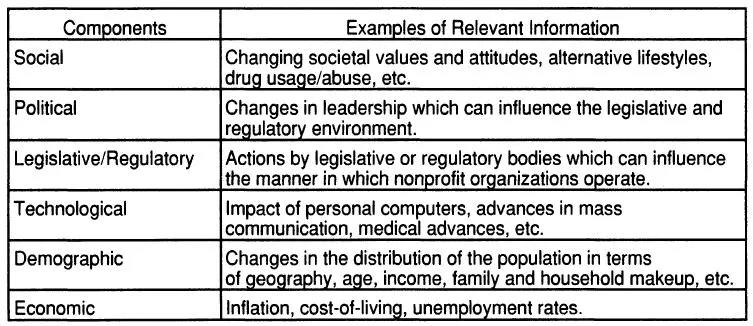![]()
INTEGRATED MARKETING COMMUNICATIONS FOR LOCAL NONPROFIT ORGANIZATIONS
Information Search: External Secondary Information for Strategic Marketing Planning in Nonprofit Organizations
Vaughan C. Judd
Betty J. Tims
SUMMARY.This article deals with the need for external secondary data for marketing planning, and the sources of such information; information available at no cost or for a nominal charge. It describes the types of information an organization might want with regard to its various
publics, its competitors, and macro-environmental forces which might affect its success. Information sources are listed and described under one of two categories, those available on the Internet and those available through traditional libraries.
[Article copies available for a fee from The Haworth Document Delivery Service: 1-800-342-9678. E-mail address: [email protected] Website: http://www.HaworthPress.com KEYWORDS: Internet information, library resources, nonprofit marketing, secondary data, marketing planning
INTRODUCTION
Nonprofit organizations need information for strategic planning purposes to assess opportunities and to plan, implement, and evaluate programs and activities in pursuit of those opportunities. Kotler and Andreason (1996) call this approach the “Strategic Marketing Planning Process (SMPP).” SMPP is broken down into three distinct stages: analysis, strategy development, and implementation. At the first stage information is needed to analyze the two environments in which an organization’s marketing plan or program must operate–the internal and external environments. This paper deals solely with the analysis of the external environments which further can be categorized as either the microenvironment–publics or stakeholders of the organization and the organization’s competitors–and the macroenvironment which consists of six distinctive spheres of influence. Figure 1 shows the elements of the process. Therein, the focus of this paper is represented by the shaded cells.
Information to analyze the external environment can come from either primary or secondary sources. Primary information is that which is “original” in the sense that it is not already available; it is generated to satisfy a specific need. Secondary information, both statistical and non-statistical, is that which is already collected and/or published for another purpose. It is available from either internal (customer or client records or knowledgeable persons within the organization) or external sources. This paper deals solely with “published” data from external secondary sources which are available at no charge, or at a minimal cost. The authors have categorized this information by broad source types-that which is available to anyone with Internet access, and that which is available at a library or through a library-related source.
It is not possible to deal with the specific needs of each type of nonprofit organization. Recommending information sources is a challenge since nonprofit organizations collectively offer a broad array of services to diverse groups of stakeholders, face a multitude of competitors, and are impacted by countless macroenvironmental factors. Sources specifically useful to health care organizations including hospitals, clinics, nursing and personal care facilities, home health care centers, and specialty facilities have not been included. Practitioners in the health care sector, however, may find this general approach to locating secondary information useful.
Figure 6.1 Strategic Marketing Planning Process
Each of the external environmental components will be discussed briefly in the following section to give the reader an idea of the type of information which might be useful.
THE EXTERNAL ENVIRONMENTS
Microenvironment: The Publics or Stakeholders
Espy (1993) categorized stakeholders into seven groups. Each of the groups can be considered as target publics for marketing programs designed to meet their needs and also the needs or objectives of the nonprofit organization. In developing plans to influence target market members, external secondary information can be helpful to the planner. Exhibit 1 lists Espy’s broad categories of stakeholders, together with the author’s perception of the related marketing challenges and needed information.
EXHIBIT 1. Stakeholders and Associated Marketing Challenges/Needed Information
Microenvironment: Competition
Competition exists at different levels ranging from very direct to rather indirect. Direct competition exists when two or more similar organizations with comparable missions and offerings compete in the same resource pool for clients, volunteers, funding, etc. Two or more agencies in a given geographic area with a mission of preventing child abuse and treating the victims would be an example of similar organizations competing for the same resource pool of clients or referral agents. These same agencies might also be considered as competing for volunteers, funding, and board members.
Indirect competition exists among organizations and offerings which seem to have little in common. Although this type of competition does not include competition for the same type of client or referral agent, it can exist when it comes to competing for the attention of other stakeholder groups. For example, the two child abuse prevention agencies cited in the preceding paragraph may have to compete with a multitude of nonprofit organizations with different missions for funding and for volunteers and board members seeking to fulfill their need to provide community service.
Information regarding competitive activity is important to a nonprofit organization in terms of positioning itself effectively when competing for customers and resources. Monitoring competitor’s actions is an activity in which organizations should engage for annual planning purposes and on a continuing basis.
The Macroenvironment
Changes or trends in the macro-environment potentially impact on an organization’s ability to meet its objectives, successfully compete for resources, and sometimes to even survive. The macro-environment is made up of social, political, legal/regulatory, technological, demographic and economic components as described in Exhibit 2.
The next section describes and differentiates between two information seeking tactics used for strategic marketing planning purposes.
EXHIBIT 2. Components of the Macroenvironment and Information Needs
INFORMATION-SEEKING TACTICS
The authors define the term “information seeking” as any activity which requires active search for information which already exists outside of the organization. Although not previously differentiated in the literature, it is useful to distinguish between two types of information seeking tactics: information search and environmental scanning.
Information Search
The authors describe information search as a process wherein certain types of information is sought because it is needed to successfully define or describe market segments; determine the segment (s) to be targeted and how the offering can be differentiated and positioned; and for understanding how the controllable elements of marketing, the marketing mix, can best be employed to satisfy needs.
Environmental Scanning
Environmental scanning, as used by marketers, is a process whereby an organization analyzes the uncontrollable environmental forces, elements and trends that affect its products and markets (Friedmann and French 1985). Renfro and Morrison (1984), discussing environmental scanning in general, stress that the external environment should be scanned for “emerging issues.” Evans (1988), describing environmental scanning as a tool for marketers, emphasizes that the process of scanning should be from a long-term perspective. For marketers then, a suggested definition of environmental scanning is that it is a process where the uncontrollable environmental forces are monitored with an eye for changes which might or will affect the organization, and for which the organization can plan ahead in terms of marketing strategy.
Differences between the two information-seeking tactics are summarized in Exhibit 3.
While Exhibit 3 delineates the differences between the two tactics, there is overlap. For example, one might be engaged in environmental scanning and in the process find information concerning the microenvironment which might be immediately useful in short-term planning, or even be important enough to cause the organization to change its short-term plan. Conversely, while one is searching for information on the microenvironment for short-term planning purposes, one might come across a significant development in the macroenvironment which might be a threat to or an opportunity for the organization in the longer-term.
INFORMATION SOURCES
There is a vast array of secondary information sources available at no cost or at a nominal charge. Many today are available electronically, either via the Internet or on CD-ROMs. While printed information continues to be readily available, much of this information is also available electronically, and some available only electronically. The authors have chosen to categorize secondary information sources into three different types: (1) information available to anyone anywhere having a computer and Internet access, (2) information accessible through library consortia and “virtual libraries,” and (3) information available from “bricks and mortar” libraries; that is “libraries with walls.” The latter includes a library’s holdings and electronic sources as well as its access to information beyond its walls. These three categories, however, are not mutually exclusive. A individual information source might be accessible via two or more of the source categories.
EXHIBIT 3. Information-Seeking Tactics
INFORMATION SOURCES: INTERNET
This section will simply provide the name of the source, its URL, and a brief description of what might be found there. Some of these sites are gateways which provide links to many different web sites. An individual gateway may provide links to hundreds of sites. The URLs are arranged alphabetically in the following categories: Federal and State Government Sources, Periodicals (including Newspapers), Organizations, and Consultants.
Federal and State Government Sources
The Administration for Children and Families (www.acf.dhhs.gov)
This site has press releases, fact sheets, reports, and other information on the many programs administered by the Administration for Children and Families. Examples of programs include the Child Care Bureau, Children’s Bureau, Head Start, and Administration for Native Americans.
AskERIC (www.askeric.org)
AskERIC is operated by ERIC Clearinghouse on Information and Technology with funding from the Office of Educational Research and Improvement at the U. S. Department of Education. It is a great source for anyone involved in education or anyone wanting information about education. It provides access to the ERIC database which is the world’s largest source of education information. More than one million abstracts of documents, journals, and books can be found in the ERIC database. Most college and university libraries will have the full-text ERIC microfiche collection. The AskERIC site also has a virtual library that provides lesson plans, information guides, etc., as well as a question and answer service.
Bureau of Labor Statistics (stats.bl...




